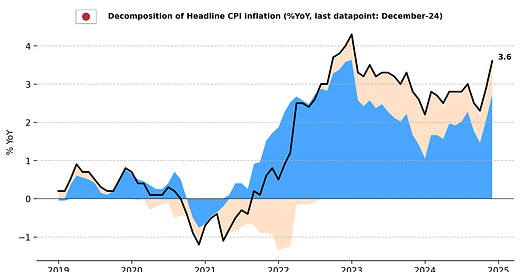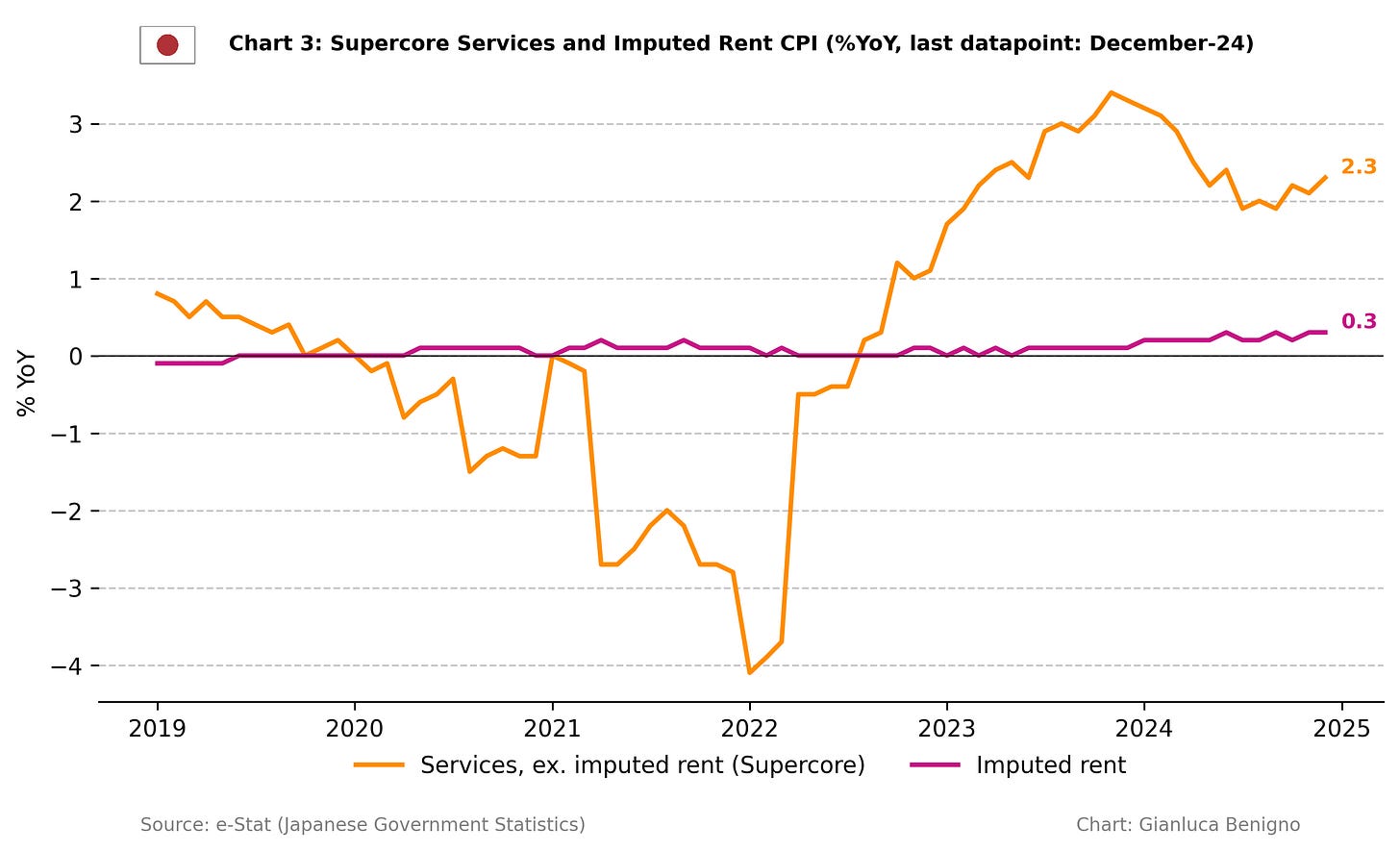Key takeaways:
Japan's Consumer Price Index (CPI) increased by 3.6% year-on-year (YoY) in December, higher than the 2.9% rise observed in November and above market expectation of an increase of 3.4% YoY.
CPI excluding fresh food, the Bank of Japan's preferred measure, rose by 3.0% YoY in December, in line with market expectations of a 3.0% YoY increase, and higher than November’s 2.7% increase.
Similarly, CPI excluding fresh food and energy rose by 2.4% YoY, in line with market consensus and November’s figure, both at 2.4% YoY.
Japan's inflation diverges from patterns seen in other advanced economies. It is primarily driven by the goods sector, which rose 5.4% YoY in December (versus 4.1% YoY in November), rather than by the services sector, which saw a 1.6% YoY rise in December, slightly higher than the 1.5% YoY recorded in November. The depreciation of the Japanese yen seen in the last quarter (and in 2024 as a whole) was a key driver of goods inflation in the country given the pass-through to imported costs.
Inflationary pressures at the level of service inflation seem to be consolidating just above 2% for service inflation less imputed rent, a welcome development for the Bank of Japan (BoJ).
The BoJ will decide its policy decision later today. It is expected to increase its policy rate by 25bps to 0.5%. The current release is consistent with the inflation outlook and the policy normalization.
Related Posts
Japan November 24 Inflation Report (previous release)
Japan October 24 Inflation Report (previous release);
Japan September-24 Inflation Report (previous release);
Japan August-24 Inflation Report (previous release);
Japan July-24 Inflation Report (previous report);
A Quasi-Global Inflation Overview (related post);
The Bank of Japan's Put (related post);
Post-FOMC Update: The Fed and the Market Shifts (related post).
Review of the Inflation Release
In December 2024, consumer prices increased by 3.6% year-on-year (YoY), higher than the 2.9% year-on-year reported in November. On a month-on-month basis, prices increased by 0.6%, compared to the 0.4% MoM increase in November.
In terms of core measures, the Bank of Japan tracks two main core inflation metrics (Chart 1): The Consumer Price Index (CPI) excluding fresh food, and the CPI excluding both fresh food and energy.
The first measure, which excludes fresh food, increased by 3.0% YoY, in line with market expectations of a 3.0% YoY rise, but higher than the 2.7% YoY increase recorded in November. On a month-to-month (MoM) basis, it increased by 0.3% MoM, lower than the 0.4% MoM increase seen in November.
The second core measure, excluding fresh food and energy, rose by 2.4% YoY, in line with the 2.4% YoY increase observed in November. On a month-to-month basis, core prices showed no change (0% MoM), lower than the 0.2% MoM rise recorded in November. As it can be inferred, energy prices, a more volatile component by nature, are still consistently driving up inflation in the country (energy prices increased by 10.1%YoY in December 2024).
In contrast to many advanced economies, where the services sector is currently still the main driver of inflation, Japan’s inflation is predominantly fueled by goods inflation (Chart 2). In December, Goods CPI increased by 5.4% YoY, much higher than the 4.1% YoY in November, while Services CPI rose by 1.6% YoY, slightly above the 1.5% YoY increase recorded in November.
On a month-on-month basis, goods inflation increased by 0.9% MoM, higher than the 0.8% MoM recorded in November. Similarly, service inflation increased by 0.2% MoM, higher than the flat reading of November.
Further emphasizing Japan's unique position, the shelter component (“imputed rents”) of the CPI has increased by 0.3% YoY, the same rate as in November. The “imputed rents" measure represents “the rent a person would have to pay to own and occupy a property” which constitutes the largest part of the CPI's housing component and weighs about 16% of the overall CPI. For a detailed breakdown of Japan's housing and rent components, refer to Tables 1 and 2.
We provide a more detailed breakdown of the components of CPI inflation (see Tables 1 and 2), including CPI inflation excluding imputed rents (Chart 4), which we consider to be the HICP-equivalent CPI. This measure facilitates international comparisons across countries and blocs, a methodology developed by the European Union Statistical Office. In December, HICP inflation rose by 4.2% YoY, significantly higher than the 3.4% recorded in November. As shown in Chart 4, HICP inflation peaked at the beginning of 2023, reaching just above 5%. Prior to the pandemic, HICP inflation fluctuated between 0% and 1% year-over-year.
Policy Implications
Inflation trends support the normalization cycle initiated last year by the Bank of Japan. Headline inflation, core CPI (excluding fresh food), and CPI excluding fresh food and energy have all amply surpassed the 2% target. From the Bank of Japan's perspective, a positive development is the steady increase in service inflation, which has remained consistently above 1% — a significant change compared to pre-pandemic levels — and stabilized around 1.5% YoY in the last quarter of 2024. However, despite the anticipated 25 basis-point hike in the call rate to 0.5%, the yen has only slightly appreciated against the US dollar over the past month. The small appreciation reflects, in part, the Federal Reserve's relatively hawkish stance following December's FOMC meeting. The current inflation data supports the likelihood of further tightening of monetary policy beyond today’s decision.
Table 1: CPI by components (% YoY)
Source: e-Stat (Japanese Government Statistics)
Table 2: CPI by components (% MoM)
Source: e-Stat (Japanese Government Statistics)










